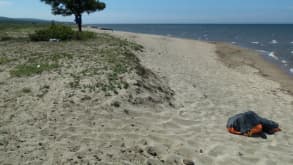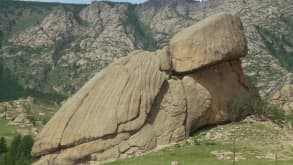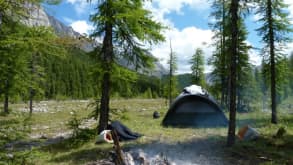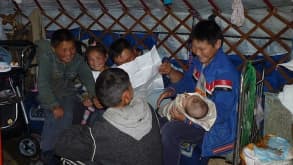Popular Topics
Trip Report
Mongolia Travel Itinerary
10 days riding around Lake Khövsgöl in northern Mongolia, through steppes and mountains. It was a total immersion in the nomadic and shamanic culture.
AsiaRussia, Mongolia20 days / July 2011
Highs & Lows
A feeling of total escape and absolute freedom
The only language of communication with nomads is Mongolian
Itinerary Overview
We arrived in Ulan-Ude by train after a 5 days journey from Moscow. This train is usually called “Trans-Siberian Railway ” because it literally crosses the South of Siberia but apart from the legend that sticks to its name, the Trans-siberian is a classic long-distance Russian train. We traveled in summer and it was a real pleasure to see the flowery landscapes of Siberia parade through the windows of the train. The train runs day and night with stops lasting between 2 and 25 minutes. During the long stops it is possible to get off the train to get some fresh air, stretch your legs or smoke a cigarette. On the station platform, you will certainly meet local merchants who sell food, chapkas and fur gloves. I do not recommend straying too far from the train because Russian trains always leave on time. In this long rail trip you completely lose the notion of time since you cross no less than 5 time zones. It is also fascinating to observe the changes in the physiognomy of the populations which gradually slides from a European typing to an Asian typing until Ulan-Ude where people look like Mongols. In terms of landscapes, my favorite part was the Irkutsk - Ulan-Ude portion where the train bypasses the gigantic Lake Baikal from the south along its banks. It gives you an incredible view.

Ulan-Ude If you're wondering where to travel in Mongolia: discover the Buryat culture and visit the eastern coast of Lake Baikal


 1+
1+Once arrived in Ulan-Ude we quickly visited the city center which remained very Soviet and as proof contains an enormous statue of Lenin's head. Yet the Ulan-Ude population is predominantly Buddhist so we also visited the two main Buddhist monasteries called "Datzan": Rinpoche Bagsha Datsan and Ivolginsky datsan. It offers a striking illustration of the cultural and religious diversity of Russia.
Then we took a small bus - called "marshrutka" - to go to the eastern shore of Lake Baikal. We spent a night in one of its many concrete, oversized and soulless resorts located on the shores of the lake. Then we decided to walk and camp directly on the sandy beaches bordering the lake on this portion. It is beautiful and wild. In the evening we witness magnificent sunsets, perhaps the most beautiful that I have ever seen. We are woken up in the morning by cows hanging out on the beach.. After two nights of wild camping, an old Buryat fisherman warned us of a storm and invited us to stay in a barn adjoining his house in a small coastal village. We spent wonderful days with him, his family and other villagers, drinking vodka, eating raw or wood-fired fish and listening to him talk about his sweet life of yesteryear, ie before the end of the USSR.

Ulaanbaatar Visit the capital of Mongolia and purchase the necessary equipment for the horseback trip



From Ulan Ude we took a bus for a 14 hours trip to Ulan Bator. We spent like 4 hours crossing the border because of long and unorganized border controls. We had to fill out a questionnaire written only in Russian and Mongolian. Once in Ulan Bator we went to the Government Palace, an imposing square in the center of the city. The next day we went to Narantuul Market - also called “black market” to get an ax, knives, and large soviet waterproof coats. WTerelj National Park e also ordered tailor-made saddles, bought reins and stirrups. In the afternoon we booked a tour organized by the hostel to visit the which contains beautiful rock formations. On the way back we stopped at the Genghis Khan Equestrian Statue, a very tall statue erected in honor of the founder of the Mongol nation.

Khuvsgul Lake Search for the "Tsaatan" people


 2+
2+We took a small soviet van (UAZ) to get to Khatgal near the Khovsgol Lake. We were 17 people in the 9 places UAZ for a 20 hours journey. It was uncomfortable but also very fun. We regularly had to leave the road which was in very bad condition. Once we got stuck crossing a river, everyone had to get out to push the van. Finally arrived, we hired horses - one per person plus 2 for the food and equipment - and 2 young guides (teenagers). Then we started our journey on horseback in search of the "Tsaatan" people, who are shamanic nomadic reindeer herders living in the forests near the lake. The adventure lasted 10 absolutely extraordinary days. We spent whole days without meeting other people, sometimes we crossed a yurt with around a herd of horses at most we saw a yurt or two on the horizon. The landscapes are varied, wild and breathtakingly beautiful: Taiga, endless stepps, mountains and lakes. In this region the main belief is animism so our route was marked out by animist places of worship, tipis to which are attached ribbons of multicolored fabrics and yak skulls. We stopped every three days in villages to get supplies. We also feed on our hunting and fishing. We slept under the stars or in tents near water points. We used tablets to purify river water for drinking. When we passed Mongolian nomads the welcome was always very warm, they offered us smoked fish, dried cheese, bread spread with mare's milk butter and - as a drink - tea and fermented horse milk called " ayrag ". The nomads speak neither Russian nor English, so we communicated by gestures and drawings on the ground, it generally worked well. By chance on July 11 we camped near a small village so we could attend the festivities of the Naadam, a big annual traditional festival which includes three moments : the traditional Mongolian wrestling fights, the archery competitions and - the most popular - the horse race between children aged 7 to 10 who ride bareback. The winner won a horse and money for the family. More than a trip it was a real wild adventure and culturally very exotic. Unforgettable.
Q & A
What would you have changed?
The night in the resort on the eastern shores of Lake Baikal. Also the Ghenghis Khan monument as well as the Terelj National Park near Ulan-Bator were not very interesting.Anything go wrong during the trip?
Only one time : our mongolian guides cheated us in the sense that they did not lead us to the Tsaatan people, they ate our food, and left us alone one night and one day without warm clothes nor water or food in the mountains. We got angry and in response they finally took the horses and provisions and abandoned us on the banks of Lake Khovsgol, without provisions or means of communication. We finally managed to call for help and get out of the woods. As they came from an important family we still had to pay them to avoid further problems. As everything ended well it was not a bad memory but it could have ended badly, and because of the guides we did not manage to meet the Tsaatan people which was the main purpose of the trip.Restaurant recommendations?
In the transsiberian there is always a restaurant car located in the middle of the train (car number 7 or 8) but the food is poor and expensive, so it’s better to take your own. Also each car is equipped with a samovar that provides free boiling water for drinking tea, instant coffee or making Chinese pasta. It is also possible to buy drinks and snacks from the provodnitsa. In Ulan Ude and Ulan Bator the food is substantially the same, consistent and inexpensive, but not very varied or elaborate. In the steppe, the nomads offered us smoked fish, dried cheese, bread spread with mare's milk butter and - as a drink - tea and fermented horse milk called " ayrag ". None of this is strictly speaking delicious but the fatigue and hunger of the trip make these meals very tasty.Tips you would give a friend?
Bringing food including chinese pastas for the train trip. Checking if there is a shower in the train before buying the ticket. Traveling with a book big enough not to get bored in the 5 day train journey, I recommend Tolstoy's "War and Peace". I also recommend not spending much time in Ulan-Ude and in Ulan-Bator cities, in both cases the most interesting things to do are clearly in the countryside. If you don’t have much time you can even skip Ulan-Ude and buy a direct train ticket from Moscow to Ulan-Bator. Moreover the Bouriat food and culture are very similar to the Mongolian one, so you won’t miss that many things.Packing tips?
Do not travel with fragile and expensive objects (computer, tablet, large camera, etc.) as they risk breaking or becoming damaged during the horse trek. Take a Mongolian dictionary because the nomads speak neither Russian nor English. For heavy equipment you can wait to be in Ulan-Bator and buy it in the Black Market, it contains a lot of Soviet army surpluses which is practical and of good quality.Transportation Tips?
For the Trans-Siberian railway you should avoid the 1st class which is far too expensive. Conversely the 3rd class - called “Platzkart” is very cheap but still comfortable. We purchased our ticket on the official Russian railway company website (RZD) only 3 days before departure because the prices are not increasing significantly with time. it cost us less than €100 from Moscow to Ulan Ude (almost 6000km). Before buying your ticket you should check if there is a shower in your train. Once in the train you have to contact the wagon manager called “provodnitsa” and pay around €2 to access the shower.
Lodging
Hotel & wild camping
Family Guest House
Wild camping



